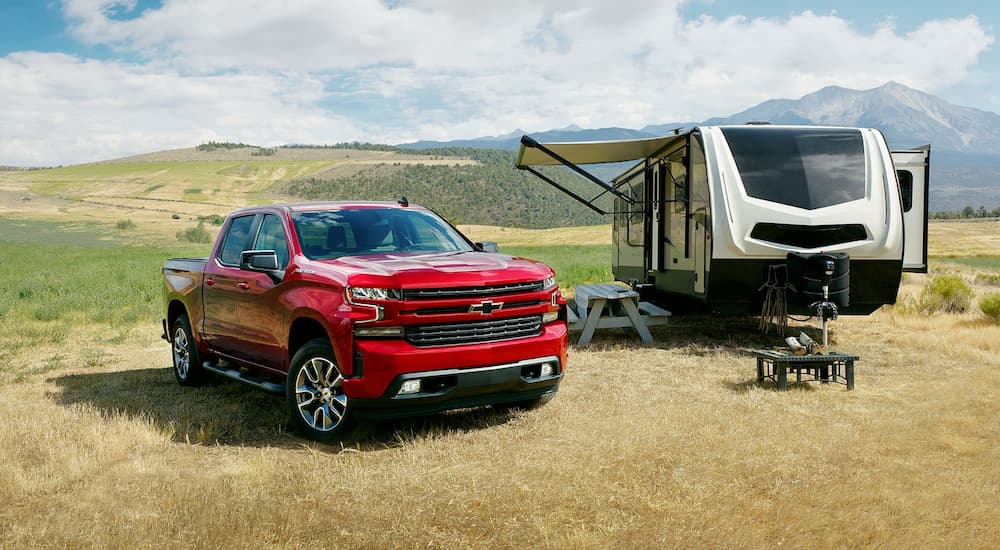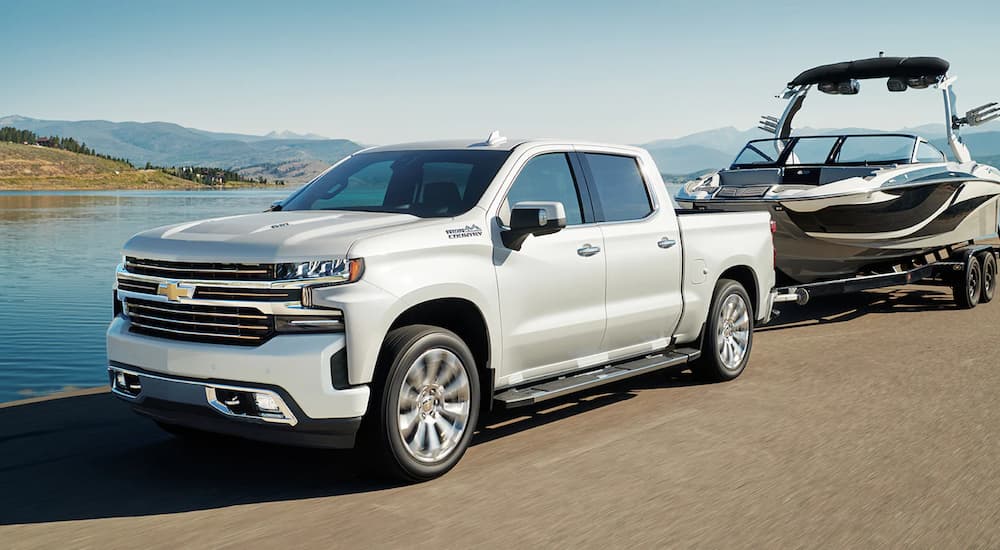Torque. It’s a conversation starter whenever talking about towing, towing capabilities, and the ability to tow efficiently. When you need the right kind of towing capacity out of a pickup truck, torque is going to be the one thing that everyone agrees on that more is better. But what happens when it’s not just about having more torque, but quicker access to torque? This is the conversation changer that the engineers at Chevy are hoping to infuse into the topic of towing and trailering with the 2022 Chevy Silverado 1500.
It’s not just about having a truck that has enough torque to get the job done and a frame that can withstand the strain and stress of towing a heavy load. You need more than that to have a light-duty truck that is considered reliable for towing, and a large part of that comes from its ability to get the drivetrain to align with its power plant capabilities. A good axle ratio with high-torque output at low RPMs is always a beautiful thing, and that’s one of the goals that the 2022 Chevy Silverado 1500 is designed to achieve, and then some.
It’s Not (Just) About the Raw Numbers
The first thing anyone might argue about when it comes to towing capabilities is the raw numbers. “This truck hits an impressive max tow rating!” or “Look at the max conventional trailering figures here!” but that doesn’t necessarily tell the whole story. Yes, the raw numbers are great because they give you an idea of what the truck is capable of achieving. But how it achieves those numbers is just as important, and whether or not it achieves those numbers efficiently is also a different story.
In the case of the 2022 Chevy Silverado 1500, it’s both about hitting higher raw figures and hitting those figures with efficiency. That’s why the available powertrains were given some very important overhauls. The turbocharged Duramax 3.0-liter diesel for the Silverado 1500 has had its max tow rating increased to 13,300 pounds, now matching the maximum towing capabilities of the 6.2-liter L87 V8 engine, despite seeing no power increases.
The 2.7-liter turbocharged inline 4-cylinder has been improved as far as raw power numbers are concerned, with an increase of 72 pound-feet of torque, bringing the total to 310 horsepower at 420 pound-feet of torque. But what’s interesting here is that not only is there more torque produced by the 2.7-liter 4-cylinder, but it does so at lower RPMs. The 2022 Silverado 1500’s 2.7-liter achieves 420 pound-feet of torque at 3,000 RPM, as opposed to the 2021 Silverado 1500’s base V6, which achieved 305 pound-feet of torque at 3,900 RPMs.

What’s The Significance Of More Torque At Lower RPMs?
According to assistant chief engineer Kevin Luchansky, Chevy completely replaced the torque converter for the 2.7-liter 4-cylinder, as well as improved the exhaust system for better efficiency, added new engine mounts, and refined the engine acoustics. All of this played a significant role in how the engineers would redefine the role of the Silverado 1500’s capabilities for improved towing, not necessarily for the biggest numbers, but for better reliability and performance. Luchansky explained that all of the overhauls, tuning, and changes have helped the 2.7-liter L3B achieve better performance and produce torque quicker than ever before.
So what’s the significance of more torque at lower RPMs in a 4-cylinder? Luchansky explains that “it comes down to how much time it takes to spool to torque. Because the L3B has four big cylinders, think of them like hammers hitting on the turbine wheel. Think of four big bangs versus six little bangs. The turbo spools up way faster. We make more torque at 1500 RPM, and we do it twice as fast. That’s why it’s a four-cylinder.”
So what does more torque at lower RPMs mean compared to spooling up to maximize effective torque output? In conjunction with a faster shifting transmission, it means more force is applied through the driveline more quickly, and that in turn means more torque to the tires off the line. Shorter spools, faster rotations, and more power.
Silverado 1500’s Faster Launch Times With Heavier Loads
When trailering and hauling heavy loads, the truck has to work that much harder to get off the line. Higher axle ratios can help with that performance, but that still relies on the engine spooling up to reach its maximum torque. In the case of the 2022 Silverado 1500, we’re looking at a turbocharged 4-cylinder that puts more power to the ground in a shorter time. So how does this help with towing? Well, it means less delay getting the truck to move while towing heavy loads and less build-up required to propel the truck forward off stops such as at traffic lights or during heavy stop-and-go traffic.
Luchansky explained that real-world testing proved that producing lower-end torque faster was the goal and that they achieved it during actual trailering exercises. “Take a new 2022 Chevrolet Silverado 1500 and that competitive truck, put a trailer behind them at equal weight, and drive away from a stoplight, and you’ll see why. We did that out at Davis Dam, and I was blown away. That was a defining moment our team still talks about.”
In short, Luchansky is saying that even if the Silverado 1500’s 2.7-liter or 3.0-liter engines don’t have the highest figures on the spec sheets when it comes to raw torque output or trailering capacity compared to the competition, it’s how they achieve those numbers that matters. Think of it as a boxer throwing fewer but faster and heavier punches than a competitor. The results will be devastating.
Keep in mind that for trailering that takes place on roads with a lot of stop-and-go traffic, this is a perfect setup. Having a truck that gets you off the line a lot faster than the competition means you’re spending less fuel on the start/stop process of travel and less wear on the engine trying to achieve usable torque at higher revolutions. You basically get more for less; it’s a win-win situation.
Real-World Testing…
It’s one thing to test payloads and trailering capacity in closed circuit tests, but nearly every enthusiast trucker who wants a light-duty model for trailering purposes is going to want to put the trucks through the grinder for themselves. Expect a lot of trailering comparisons under different loads, weather conditions, and road surfaces. A lot of people are going to want to know how well the 2022 Chevy Silverado 1500 handles in comparison to the competition under similar loads.
Figures on a sheet only tell part of the story, and so far, it looks like the engineers are certainly on the right track with the Silverado 1500, focusing more on efficiency rather than just achieving high raw numbers. It’s easy to forget that it takes more than just a bunch of cylinders firing all the time to make the most use out of a truck’s potential power, and that seems to be the aim of the Silverado 1500.
Of course, we won’t know for sure how well the 2022 Chevy Silverado 1500 will fare until it can be put through the proverbial grinder in grueling tests against competitors. What the engineers have achieved so far probably looks mouth-watering for anyone looking for a fuel-efficient, full-size pickup that has a lot of power to boot with very minimal effort. There are definitely exciting times ahead as competition heats up for the 2022 showdown among the light-duty trucks from some of the biggest and most exciting brands out there.





